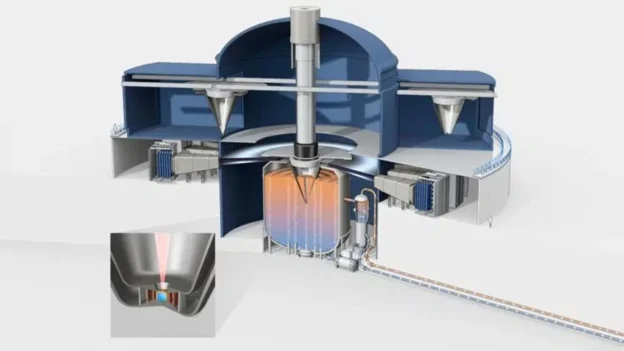UK-based First Light Fusion (FLF), a spin-off from Oxford University, has unveiled a new route to commercially viable fusion power based on an innovative high-gain inertial fusion approach.
Fusion energy technology
The method, called FLARE (Fusion by Low Power and Rapid Excitation Assembly), promises to transform the global energy landscape by offering a more economical, scalable and technically realistic alternative for clean electricity generation.
Unlike conventional inertial fusion schemes, which compress and heat the fuel simultaneously, FLARE separates the two processes: it first compresses the fuel in a controlled and efficient manner, and then ignites it using an auxiliary source, such as a short-pulse laser or pulsed power system. This technique, known as “fast ignition,” has been theoretically explored for years, but FLF claims to have turned it into a practical solution thanks to its controlled amplification technology.
“With FLARE, we have charted the first reactor-compatible path to achieve an energy gain of up to 1,000, well above the threshold needed to make fusion economically transformative,” stated Mark Thomas, CEO of First Light Fusion.
“With FLARE, we have charted the first reactor-compatible path to achieve an energy gain of up to 1,000, well above the threshold needed to make fusion economically transformative,” stated Mark Thomas, CEO of First Light Fusion.
Currently, the record energy gain is 4, achieved by the U.S. Department of Energy’s National Ignition Facility (NIF) in May 2025. According to FLF models, a gain of at least 200 is needed for fusion to compete commercially with other energy sources, while a gain of 1,000 would allow electricity to be produced at extremely low costs.
The FLARE design also reduces capital and operating costs. An experimental facility based on this model would cost just one-twentieth of what is required for an high-power fusion plant plant such as NIF, and could be built with off-the-shelf technologies. In addition, the lower pulse frequency and operational flexibility would allow these plants to be easily integrated into modern power grids with high penetration of intermittent renewables.
FLF plans to validate each component of the system in existing experimental facilities, and subsequently design and prototype its first demonstration reactor. The goal: to open the door to a new global energy industry based on clean, safe and affordable fusion.
Source and photo: First Light

